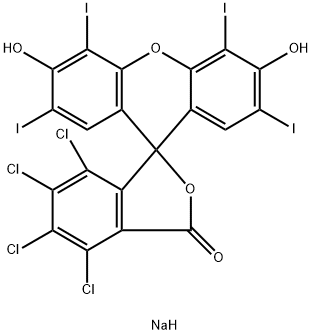|
ChemicalBook Optimization Suppliers |
| 名前: |
Rhawn Reagent Gold |
| 電話番号: |
400-400-1332688 18019345275 |
| 電子メール: |
amy@rhawn.cn |
| 名前: |
Alfa Aesar |
| 電話番号: |
400-6106006 |
| 電子メール: |
saleschina@alfa-asia.com |
|
| 化学名: | 食用 赤色 105号 | | 英語化学名: | Acid Red 94 | | 别名: | 4’,5’,7’-tetraiodo-droxy-2disodiumsalt;9-(3’,4’,5’,6’-tetrachloro-o-carboxyphenyl)-6-hydroxy-2,4,5,7-tetraiodo-3-is;foodredcolorno.105,sodiumsalt;foodredno.105,sodiumsalt;oxanthone2na;r105sodium;rosebengalsodium;Rozebengal,sodiumsalt | | CAS番号: | 632-69-9 | | 分子式: | C20H5Cl4I4NaO5 | | 分子量: | 997.66 | | EINECS: | 211-183-3 | | カテゴリ情報: | RB;Organics;Food Colors by Food Sanitation Law in Japan;Analytical Chemistry;Xanthene | | Mol File: | 632-69-9.mol |  |
| 融点 | >300°C | | 貯蔵温度 | Store at +15°C to +30°C. | | 溶解性 | H2O: soluble1mg/mL | | カラーインデックス | 45440 | | 外見 | Solid | | 酸解離定数(Pka) | 3.9, 4.7(at 25℃) | | 色 | Red-brown | | 水溶解度 | soluble | | Sensitive | Light Sensitive | | 極大吸収波長 (λmax) | 548 nm | | Merck | 14,8262 | | BRN | 3645857 | | 生物学的応用 | Apoptosis assay; diagnosis of diseases related to amyloid accumulation; controlling plant diseases; identifying fungi; treating skin,mouth,digestive tract,urinary tract,reproductive tract,respiratory tract,circulatory system | | CAS データベース | 632-69-9(CAS DataBase Reference) | | EPAの化学物質情報 | Spiro[isobenzofuran-1(3H),9'-[9H]xanthen]-3-one, 4,5,6,7-tetrachloro-3',6'-dihydroxy-2',4',5',7'-tetraiodo-, disodium salt (632-69-9) |
| | 食用 赤色 105号 Usage And Synthesis |
| 外観 | 赤褐色の粉末 | | 溶解性 | 水に易溶、酸に不安定。水に溶けて赤紫を呈する。 | | 解説 | 色名の一つ。JISの色彩規格では「あざやかな紫みの赤」としている。一般に、バラ科バラ属植物の花のような紫みを帯びた赤をさす。バラは西洋最古の園芸植物で多様な色の花を咲かせるが、そのなかで「あざやかな紫みの赤」に注目した色名。「あざやかな赤」を表すローズより少し淡い色をしている。JISの色彩規格ではローズレッドのほか、洋名としてローズ、ローズピンク、オールドローズなどをそれぞれ定義している。
講談社 色名がわかる辞典について 情報 | | 用途 | ローズベンガル (rose bengal) は、色素の一種で、食品や生体試料などを赤色に着色するために用いる着色料。タール色素に分類される合成着色料である。ナトリウム塩は食用赤色105号として食品添加物の指定を受けている。旧厚生省は天然に存在しない添加物に分類している。
ローズベンガルの構造は、フルオレセインが持つ水素8個を塩素4個とヨウ素4個で置換したものである。カリウム塩もまた、着色料として用いられる。
光反応において光増感剤として用いられる。基底状態である三重項状態の酸素分子から、光照射により一重項酸素を発生させる際にローズベンガルが添加される。 | | 説明 | Rose bengal is a xanthene dye, fluorescein derivative, and photosensitizer. It exhibits absorption/emission maxima of 548/567 nm, respectively. Rose bengal binds to S. aureus cells and decreases survival of photoirradiated S. aureus to 0.012% when used at a concentration of 1 μM. It generates singlet oxygen when exposed to photoirradiation in cell-free assays and induces potassium ion leakage from S. aureus and bovine erythrocytes in the presence of photoirradiation. Rose bengal inhibits the cytochrome P450 (CYP) isoform CYP3A4/5 and the UDP-glucuronosyltransferase (UGT) isoform UGT1A6 in human liver microsomes in a light-dependent manner, with IC50 values of 0.072 and 0.035 μM, respectively, in yellow light, 3.1 and 4.2 μM, respectively, in ambient light, and 3 and 4.2 μM, respectively, in the dark. It has been used for staining of live cells, but exhibits both intrinsic and phototoxicity. | | 化学的特性 | bordeaux-red to red-brown crystalline powder | | 使用 | For research use only. Not for use in diagnostic procedures.
Please refer to the attached Protocolfor details. | | 使用 | Rose Bengal Sodium Salt is used in biological studies as potential for use as sensitizers in photodynamic and sonodynamic therapy by synthesizing Rose Bengal amphiphilic derivatives. This compound has neuroprotective properties. | | 一般的な説明 | This ELISA antibody pair detects Bovine IGF-1 | | 安全性プロファイル | An experimental teratogen. Experimental reproductive effects. Questionable carcinogen with experimental neoplastigenic data. When heated to decomposition it emits toxic fumes of Cl-, I-, and NazO. | | Veterinary Drugs and Treatments | Rose bengal is a vital stain and stains dead epithelial cells and mucus.
Full thickness loss of the corneal epithelium is not necessary
(only dead cells need be present) to obtain rose bengal stain uptake.
It does not stain epithelial defects and does not pass into intercellular
spaces.
Rose bengal stain is most commonly employed in the detection
of the presence of viral keratitis in the cat. Because feline herpes virus
tends to infect one cell, moving then to an adjacent cell (causing
the so called dendritic tracts in the cornea) without full thickness
loss of corneal epithelium initially, rose bengal is an ideal diagnostic
agent for this infection. Rose Bengal can also be used to detect damaged
corneal epithelium on the dorsal cornea in early cases of keratoconjunctivitis
sicca. Rose bengal stain is virucidal although no
information is available relative to its use as a therapeutic agent. | | in vitro | rose bengal was a quite potent membrane-permeant inhibitor of glutamate uptake into isolated synaptic vesicles. such vesicular glu uptake inhibition was achieved without affecting h1-pump atpase. it was found that various degrees of reduction elicited by rose bengal in [3h]glu in synaptic vesicles inside the synaptosome [1]. | | in vivo | the distribution of i.v. administered rose bengal was found to depend on its dose. at a low dose, rose bengal could be found almost solely in the liver and plasma. however, at higher doses, the amount of rose bengal found in extra-hepatic tissues gradually increased. the hepatic transfer maximum of rose bengal amounted to 146 micrograms/kg/min. by increasing the dose from 10 to 200 mg/kg, the hepatic concentration of rose bengal also approached a maximum. the storage capacity of the liver, however, did not limit the transfer maximum of rose bengal [1]. | | 貯蔵 | Store at RT | | 純化方法 | This biological stain can be purified by chromatography on silica TLC using a 35:65 mix of EtOH/acetone as eluent. [Beilstein 19 II 261, 19 III/IV 2926.] | | 参考文献 | [1] ogita k,hirata k,bole dg,yoshida s,tamura y,leckenby am,ueda t. inhibition of vesicular glutamate storage and exocytotic release by rose bengal. j neurochem.2001 apr;77(1):34-42.
[2] fischer e,varga f. hepatic storage and biliary excretion of rose bengal in the rat. acta physiol acad sci hung.1979;54(1):89-94. |
|